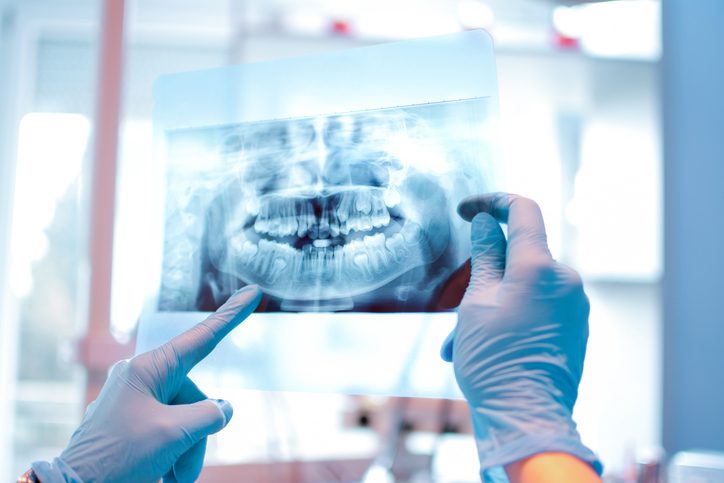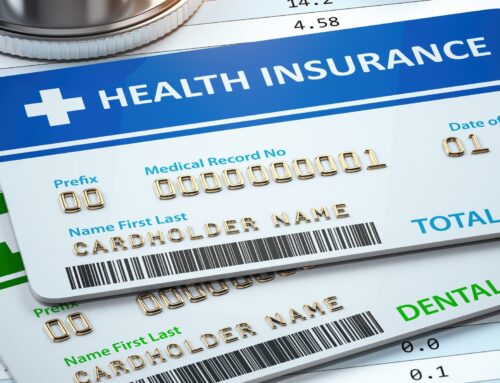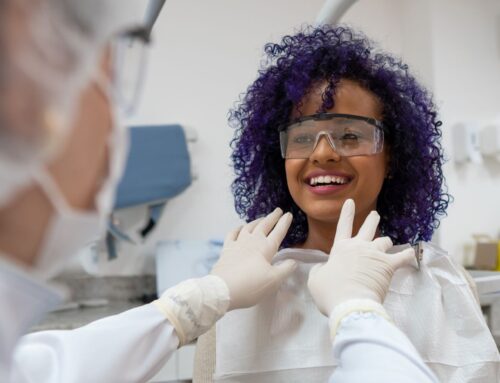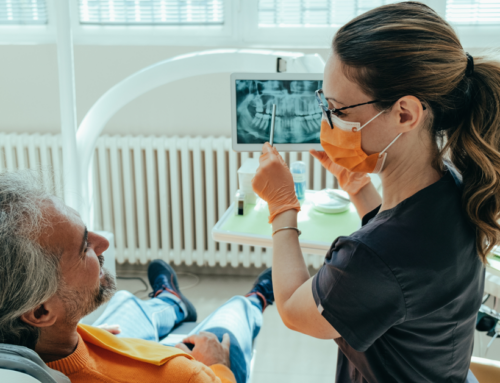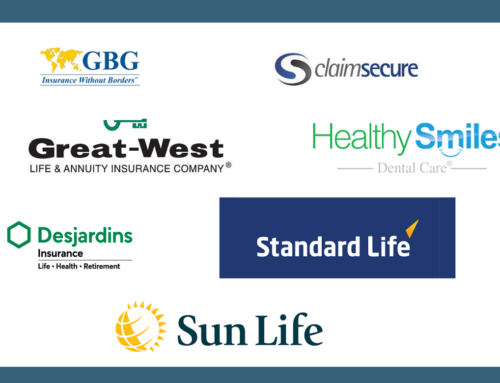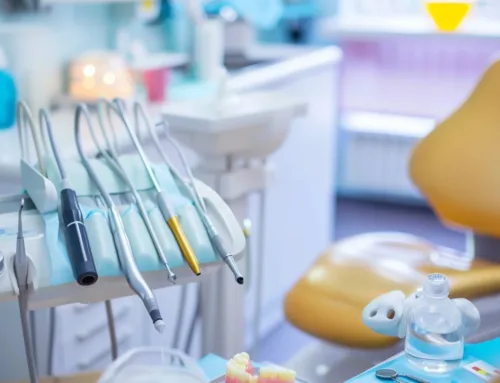Dental Exams: Are Dental X-rays Safe?
X-rays are images of your teeth and gums that dentist use to evaluate your oral health and determine if there are any issues that require treatment. They are an electromagnetic wave of high energy combined with short wavelength, which can permeate materials that are opaque to light. Despite being a medical marvel in every way, x-rays are still haunted by concerns about their safety.
X-rays are a standard part of dental exams here at Barrie Dentist. Just because you’re used to seeing that bulky x-ray machine or having to wear that heavy vest, doesn’t mean that there aren’t risks associated with this technology. It’s important to understand what your mouth is enduring because there’s no value to being left in the dark about your oral health.
What risks do x-rays pose and how does the technology actually work? We’ll review some of the concerns surrounding x-rays so you can determine if you are comfortable with them being part of any future treatments. Finally, we’ll look at our preferred method, digital x-rays, to illustrate why we believe they are the best and safest bet.
General Dental Exams
Think of the mouth as the beginning of your personal health journey. Georgian Dental® works to care for the mouth of patients so they can achieve the healthy lifestyle they desire. To promote oral health, we recommend that patients book regular examinations either annually or bi-annually.
Barrie Dentist uses a holistic approach to perform dental exams which always begin with a conversation to assess a patient’s needs, lifestyle and priorities. Then, we use digital imaging technology to take a detailed set of digital photos of your teeth and gums, including your jawbone. Once the x-rays have been taken, the hygienist can continue the exam while the dentist can instantly check for any abnormalities. Lastly, what we learn during your exam informs a treatment plan that we use to help ensure you have healthy teeth and gums and can achieve a radiant smile.
Unless there is something in your oral history that requires special attention or care from a dentist or specialist, a dental exam should be routine and relatively fast and comfortable.
Evolution of X-rays
Despite any reservations, real or perceived, x-ray imaging was one of the most important developments in the history of dentistry. Dentists often need to treats issues below the gumline. Without the aid of x-rays, they would be forced to make an incision and turn something simple into an invasive and painful procedure.
The x-ray was first discovered in 1895 by Wilhelm Röntgen and in 1896 the first dental x-ray was taken by C. Edmund Kells in New Orleans. Over the decades, the technology advanced to feature faster film speed, better quality images and increased comfort for patients. Eventually, x-rays were established as an acceptable and necessary tool for dentists. By the 1950s, they were in regular use and today are present in every clinic in North America.
Dentists have several options with regards to the type of dental x-rays they can perform. Some of the more common are:
- Bitewing, a technique where the patient bites a specific type of paper as the x-rays are taken. This allows the dentist to see how the crowns of the teeth match up and to diagnose gum disease and cavities.
- Occlusal is done with the jaw closed so the dentist can examine how the upper and lower rows of teeth meet. It also provides insight into the roof of the mouth known as the palate.
- Panoramic is a x-ray that rotates around the face. This helps the dentist examine wisdom teeth and jaw abnormalities.
- Extraoral takes images of areas outside the gum and teeth. It allows a dentist to inspect a patient’s jaw.
We always recommend speaking with your dentist or dental hygienist about your x-rays. It’s never a bad idea to ask what x-rays are being taken and for what reasons, especially if it will put you at ease.
Dangers of X-Rays
The important thing to understand about dental x-rays is that they use radiation. The level of radiation, though, is so low that it doesn’t pose much of a threat. Granted, not being exposed to any amount of radiation is always best.
You’ve probably noticed that with traditional x-rays, everyone besides the patient leaves the room. This might be alarming but remember, dentists and dental hygienists take hundreds of x-rays a week. Despite each session only emitting a small amount of radiation, the sheer number of x-rays taken could be dangerous to their health. This shouldn’t concern the patient who is only having x-rays taken a few times a year at most.
There are certain factors that could impact how often a patient can have dental x-rays performed or increase the level of danger. These include:
- Age
- Current state of oral health
- Showing symptoms of oral disease
- A history of gingivitis or tooth decay
- Pregnancy
The radiation from dental x-rays is roughly the same amount that we get from our TVs or from a full day outdoors in the sun. This might not raise an eyebrow but you need to remember that dental x-rays can provide a whole day’s worth of solar radiation in only seconds. This in addition to the normal amount of radiation you receive every day can cause concern. While the danger is still minimal when it comes to things like radiation exposure, it’s always best to be prudent.
Beyond the use of low levels of radiation, x-rays don’t present a great health risk to the average patient. The benefits of a dentist being able to detect tooth decay, diseases in the jaw bone, periodontal disease, infections and even tumors far outweigh the slight risks involved.
Digital X-rays
Digital x-rays were an enormous innovation in the field of dentistry and not just because it’s a safer method. It helps dentists and specialists expedite their diagnosis and start treatment quicker because they can clearly and quickly identify issues.
We pride ourselves on offering our patients the most advanced technologies to create more convenient and comfortable treatments. The more information we have about a patient’s teeth and gums, the more likely we will be able to pinpoint any problems and provide the highest standard of care.
In addition to providing quicker insights into a patient’s case while exposing them to minimal radiation, digital x-rays allow the dentist to control the contrast, colour and brightness. This control is essential to providing our patients with the best oral care.
Insurance Coverage
OHIP doesn’t cover dental services apart from dental surgeries performed in a hospital. This means that x-rays are charged to patients at an additional cost. Most group benefits cover dental x-rays but that is decided by your employer.
Be sure to review your benefits plan or speak with your benefits administrator to see what dental services are covered.
Book an Appointment at Barrie Dentist Today!
There is very little risk with respect to dental x-rays so you shouldn’t worry during your next exam. If you are still concerned or want to err on the side of caution while still receiving the best dental care, then consider Georgian Dental®.
Are you due for a checkup? Book your appointment today and we’ll be happy to answer your questions and help you get your smile in style!
READY TO GET THE SMILE YOU ALWAYS WANTED?
Appointment Request
If you’re interested in any of our procedures, and would like to meet with one of our dentists to discuss options, costs and get additional information, complete this short form and we’ll give you a call to arrange for a no-obligation appointment at our Barrie clinic.
